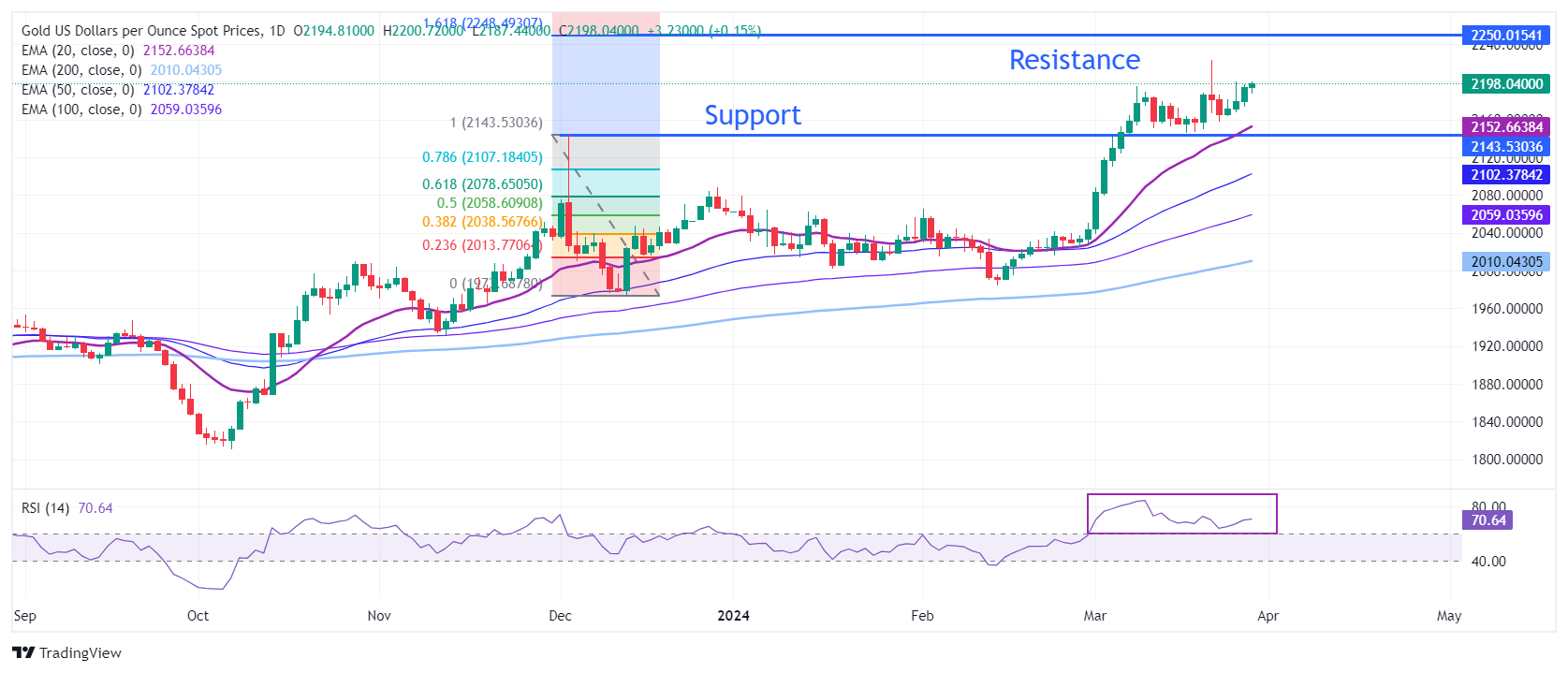Gold price holds strength ahead of US core PCE inflation
- Gold price hovers around $2,200, exhibiting strength ahead of US core PCE Price Index data.
- The US Dollar refreshes to a six-week high amid cautious market sentiment.
- 10-year US bond yields rise as Fed rate cut bets for June have dropped.
Gold price (XAU/USD) holds onto gains near $2,200 in Thursday’s European session. The precious metal exhibits firm footing ahead of the United States core Personal Consumption Expenditure (PCE) Price Index data for February, which will be published on Friday.
The Federal Reserve (Fed) could dial back rate cut expectations if the underlying inflation data suggests price pressures persist. Such a scenario would lead to an increase in yields on interest-bearing assets, such as Treasury bonds, whose appeal strengthens in a high-inflation environment. On the contrary, softer-than-expected inflation could boost expectations for a Fed rate cut in the June meeting, and support the broad narrative of three rate cuts for overall 2024.
The Fed is expected to maintain a cautious approach to rate cuts as initiating them too soon or lowering them too much could reinforce price pressures again. Meanwhile, a delay in cutting interest rates could result in unnecessary pressure on the labor market and the economy.
The US Dollar Index (DXY), which measures the US Dollar’s value against six major currencies, refreshes to a six-week high at 104.72 amid dismal market sentiment ahead of the release of the Fed’s preferred inflation gauge.
Daily digest market movers: Gold price rises slightly while US Dollar refreshes six-week high
- Gold price holds gains slightly below $2,200 ahead of the US core PCE Price Index data for February. The Federal Reserve’s preferred inflation gauge is expected to have grown at a steady pace of 2.8% on year. The monthly underlying inflation data is forecasted to have increased by 0.3%, slowing from January’s 0.4% advance. Investors will keenly focus on the inflation data to gauge when the Fed may begin trimming interest rates.
- Stubborn inflation data could allow the Fed to maintain a hawkish rhetoric. Fed policymakers have been reiterating that rate cuts are only appropriate when they are convinced that inflation will return sustainably to the 2% target. Sticky price pressures, in turn, would weaken the Gold’s appeal as it would increase the opportunity cost of investing in it.
- According to the CME FedWatch tool, traders are pricing in a 60% chance that a rate cut will be announced in June. The chances for Fed pivoting to rate cuts in June have dropped from 70% on Thursday after a slightly hawkish guidance from Fed Governor Christopher Waller.
- Christopher Waller said in a speech at an Economic Club of New York on Wednesday that the Fed needs not to rush for rate cuts. However, he keeps hopes of rate cuts alive saying, “Further progress expected on lowering inflation will make it appropriate for the Fed to begin reducing the target range for the federal funds rate this year," reported Reuters.
Technical Analysis: Gold hovers close to $2,200 resistance
Gold price trades close to the crucial resistance of $2,200. The precious metal aims to recapture the all-time highs slightly above $2,220. All short-to-long term Exponential Moving Averages (EMAs) are sloping higher, suggesting strong near-term demand.
The Gold price could face a hurdle near $2,250, which coincides with the 161.8% Fibonacci extension, after breaking above the resistance of $2,220. The Fibonacci tool is plotted from December 4 high at $2,144.48 to December 13 low at $1,973.13. On the downside, December 4 high at $2,144.48 will support the Gold price bulls.
The 14-period Relative Strength Index (RSI) rebounds after cooling down to 64.00 from the extremely overbought zone.
Gold FAQs
Gold has played a key role in human’s history as it has been widely used as a store of value and medium of exchange. Currently, apart from its shine and usage for jewelry, the precious metal is widely seen as a safe-haven asset, meaning that it is considered a good investment during turbulent times. Gold is also widely seen as a hedge against inflation and against depreciating currencies as it doesn’t rely on any specific issuer or government.
Central banks are the biggest Gold holders. In their aim to support their currencies in turbulent times, central banks tend to diversify their reserves and buy Gold to improve the perceived strength of the economy and the currency. High Gold reserves can be a source of trust for a country’s solvency. Central banks added 1,136 tonnes of Gold worth around $70 billion to their reserves in 2022, according to data from the World Gold Council. This is the highest yearly purchase since records began. Central banks from emerging economies such as China, India and Turkey are quickly increasing their Gold reserves.
Gold has an inverse correlation with the US Dollar and US Treasuries, which are both major reserve and safe-haven assets. When the Dollar depreciates, Gold tends to rise, enabling investors and central banks to diversify their assets in turbulent times. Gold is also inversely correlated with risk assets. A rally in the stock market tends to weaken Gold price, while sell-offs in riskier markets tend to favor the precious metal.
The price can move due to a wide range of factors. Geopolitical instability or fears of a deep recession can quickly make Gold price escalate due to its safe-haven status. As a yield-less asset, Gold tends to rise with lower interest rates, while higher cost of money usually weighs down on the yellow metal. Still, most moves depend on how the US Dollar (USD) behaves as the asset is priced in dollars (XAU/USD). A strong Dollar tends to keep the price of Gold controlled, whereas a weaker Dollar is likely to push Gold prices up.







